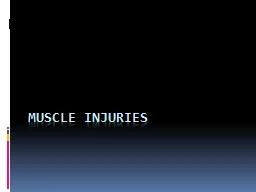

Strain Contusion Muscle Soreness Tendinitis and Tendinosis Impingement Syndromes Muscle Strains 3 Grades Only difference between sprains and strains is grade 3 there is massive pain and it does not go away ID: 779204
Download The PPT/PDF document "Muscle Injuries Types of Injuries" is the property of its rightful owner. Permission is granted to download and print the materials on this web site for personal, non-commercial use only, and to display it on your personal computer provided you do not modify the materials and that you retain all copyright notices contained in the materials. By downloading content from our website, you accept the terms of this agreement.
Slide1
Muscle Injuries
Slide2Types of Injuries
Strain
Contusion
Muscle Soreness
Tendinitis and
Tendinosis
Impingement Syndromes
Slide3Muscle Strains
3 Grades
Only difference between sprains and strains is grade 3 there is massive pain and it does not go away.
Slide4Muscle Strains
All Strains and Sprains are graded on a 3 tier scale
Grade 1 – Mild
Local pain w/ little bruising (ecchymosis).
Little to no loss of strength.
Grade 2 – Moderate
Moderate pain/ bruising/ swelling
Impaired muscle function (i.e. limping)
Grade 3 – Severe
Loss of muscle function
Palpable defect
Slide5Contusions (Bruises)
From Direct blows.
Tissue explode from force.
Discoloration is usually a sign things are improving
Hip Pointer
Thigh Contusion
Slide6Compartment Syndrome
Acute compartment syndrome is a 911 emergency
Happens from direct blows to the anterior aspect of lower leg (shin) or a fracture of Tibia
Signs:
Rapid swelling
Foot drop
Intense pain
Numbness on top of foot
Slide7Fasciotomy
Slide8Myositis
Ossificans
When a bruise turns really bad.
Bone growth in muscles as a protection mechanism
Occurs because of repeated trauma to the same area
Slide9Soreness
Two Types
AOMS
DOMS
Acute Onset
Pain usually gone in 24-48hrs
Causes muscle improvement
Slide10DOMS
Delayed Onset Muscle soreness
Causes by hypoxic injury to muscle tissue.
Cell Death
Takes 2-3 days before you feel sore.
Pain finally subsides 10-14 days later.
Slide11Tendinitis
vs
Tendinosis
Tendinosis
characterized by a degeneration of the tendons
Chronic Condition
Tendinitis
caused by an inflammation of the tendons
Acute Condition
Slide12Achilles Tendinitis
vs
Tendinosis
Achilles Tendinitis
Overuse or Eccentric Injury
Tendinitis is the acute phase (first 21 days)
Achilles
Tendinosis
Chronic Phase (after 21 days)
PRP Treatment
Slide13Achilles Tendon Rupture
Sounds like a gun shot.
Weekend Warrior
Most commonly had Achilles Tendinitis or
Tendinosis
Slide14Jumper’s Knee
Patellar Tendinitis
Either an Overuse or Eccentric Injury
Usually caused by issues in the foot or muscle weakness in the hip and knee is having to compensate.
Slide15Runner’s Knee
Iliotibial (IT) band Syndrome
Tight Hip abductors
Pain in Lateral aspect of knee by knee cap
Slide16Osgood
Schlatter’s
and
Sever’s
Apophysitis
Injuires
-
(Growth plate attachments where muscles are pulling)
Occurs during pre-puberty or puberty times
Extremely PainfulCan lead to future impairments for athletes as grow into adulthood
Opposite of Osgood is called Larson-
Johannson
Slide17Shoulder Impingement
Sometimes referred to as Rotator cuff tendinitis this condition is an irritation of these tendons and inflammation of the bursa (a normally smooth layer) lining these tendons.
Causes:
Keeping the arm in the same position for long periods of time, such as doing computer work or hairstyling
Sleeping on the same arm each night
Playing sports requiring the arm to be moved over the head repeatedly as in tennis, baseball (particularly pitching), swimming, and lifting weights over the head.
Working with the arm overhead for many hours or days (such as painters and carpenters)
Poor control or coordination of your shoulder and shoulder blade muscle
s
Slide18Carpal Tunnel
Carpal tunnel syndrome is pressure on the median nerve
It can lead to numbness, tingling, weakness, or muscle damage in the hand and fingers.
Carpal tunnel syndrome is common in people who perform repetitive motions of the hand and wrist. Typing on a computer keyboard is probably the most common cause of carpal tunnel. Other causes include:
Driving
Assembly line work
Painting
Writing
Use of tools (especially hand tools or tools that vibrate)
Racquet Sports such as Tennis or racquetball
Slide19Rotator Cuff Tear and SLAP
Supraspinatus
tear
Commonly involves Long Head Biceps tendon
S = Superior
L = Labrum
A= Anterior
P=Posterior
Slide20Tommy John Injury